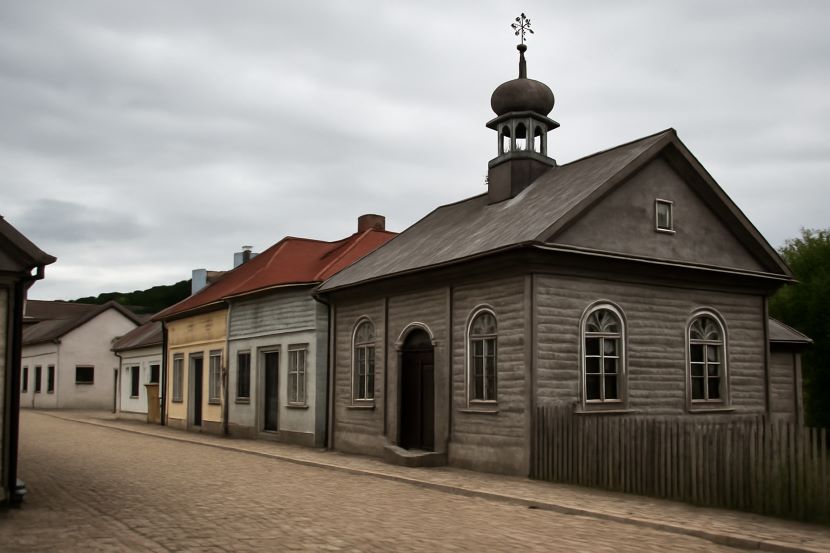Published on
September 21, 2025
To honor and keep alive the memory of Lithuania’s Jewish past, the nation recently unveiled the “Lost Shtetl” Museum. Nestled in the country’s northern countryside, it’s now the biggest museum of its kind in all the Baltic States. The museum’s goal is clear: teach everyone who walks through its doors about the vibrant Jewish life that flourished across Lithuania until the Holocaust brought it to a painful end.
Recreating the Shtetl Experience
Before Nazi occupation in 1941, many Jewish families in Lithuania lived in small towns, known as shtetls. These towns were vibrant communities, where Jews coexisted peacefully with their non-Jewish neighbors. One such town was Šeduva, home to 700 Jews, all of whom perished or fled during the Holocaust. The Lost Shtetl Museum honors these communities, specifically the people of Šeduva, who were driven into nearby forests by the Nazis in August 1941 and murdered. The town was left in ruins, and only a handful of survivors, some who had fled earlier or were sheltered by Lithuanian families, remained.
A Personal Connection to the Past
The museum exists today thanks to the hard work of a Šeduva descendant who belongs to the Jewish community. After the person traced their family history, they chose to help pay for part of the new museum. What began as an effort to protect a nearby Jewish cemetery soon expanded into a full center telling the story of Jewish life across Lithuania and the terrible loss that eventually took place. Writer Sergejus Kanovičius, the Zurich-based FSU Education Association, and many friends and supporters from around the globe stepped in with their time, ideas, and funds together, they helped shape the museum into what it is now.
Exhibitions Reflect the Life and Tragedy of Lithuanian Jews
Spanning an impressive 3,000 square meters, the museum is home to ten thematic exhibitions that offer an immersive experience into the history of Lithuania’s Jewish population. These exhibitions include photographs, personal testimonies, and authentic artifacts from the Jewish communities of Lithuania. Items such as a Torah scroll and the memoirs of a young girl provide visitors with a deeply personal view of the lives lost.
The museum’s exhibitions are organized chronologically, starting with the “Golden Age” of Jewish life in Lithuania during the interwar period. Visitors can explore the vibrant cultural and religious life that flourished before the Nazi occupation. As the narrative progresses, the museum delves into the devastating impact of Soviet and Nazi occupation, leading to the destruction of these communities.
The Multi-Sensory “Path of Death” Exhibit
The museum’s most striking and emotional exhibit is the multi-sensory “Path of Death,” which recreates the harrowing final moments of the residents of Šeduva as they were forced into the nearby forests to be killed. This exhibit is designed to evoke an emotional response from visitors, encouraging reflection on the atrocities that occurred.
The exhibit features glass floors, beneath which visitors can see the forest floor, providing an eerie glimpse into the tragic fate of the townspeople. As visitors walk down a dark corridor, they are immersed in the sounds of the forest, the smell of the woods, and the visuals of documentary footage shot in the Šiauliai ghetto, where many of the victims had been held before their final journey. The exhibit serves as a stark reminder that these historical events must be remembered and reckoned with in the present.
Museum Opening and Visitor Information
The “Lost Shtetl” Museum officially opened on September 20, 2025, and will be open to the public free of charge for one year. However, due to the museum’s high demand, reservations are required for entry. It is recommended to book tickets in advance to ensure a spot, as the museum anticipates a large influx of visitors, especially during the first year of operation.
Guide for Travelers
The “Lost Shtetl” Museum is located in the small town of Šeduva in northern Lithuania, about a two-hour drive from Vilnius, the capital. Visitors traveling from the capital can easily reach the museum by car, bus, or train. The surrounding region offers scenic views and is home to several historical sites, making it a great destination for travelers interested in exploring Lithuania’s rich history and cultural heritage.
For those interested in learning more about Lithuania’s Jewish history and the shtetl culture, the museum provides an insightful, educational, and emotionally charged experience. It is a fitting tribute to the Jewish communities that once called Lithuania home, allowing visitors to understand the magnitude of their loss while reflecting on the resilience of their descendants.
Overview
Inaugurating the “Lost Shtetl” Museum is a milestone for safeguarding the collective memory of Lithuania’s once-thriving Jewish communities and the traditions that shaped them. Set against a backdrop of profound loss, the museum starkly illuminates the legacy of the Holocaust, pressing visitors to reckon with a past that demands never-ending vigilance. Beyond memorialising those who perished, the space invites reflection and study, transforming the recollection of a vanished. village into an enduring pedagogical resource for generations to come.
